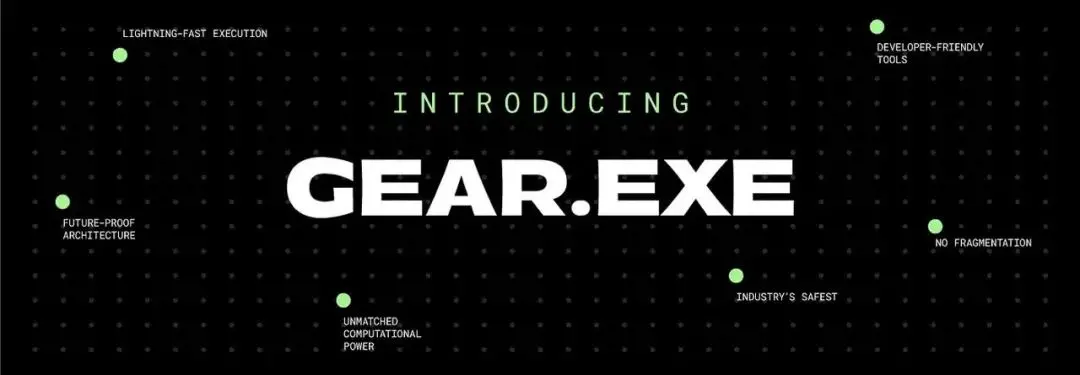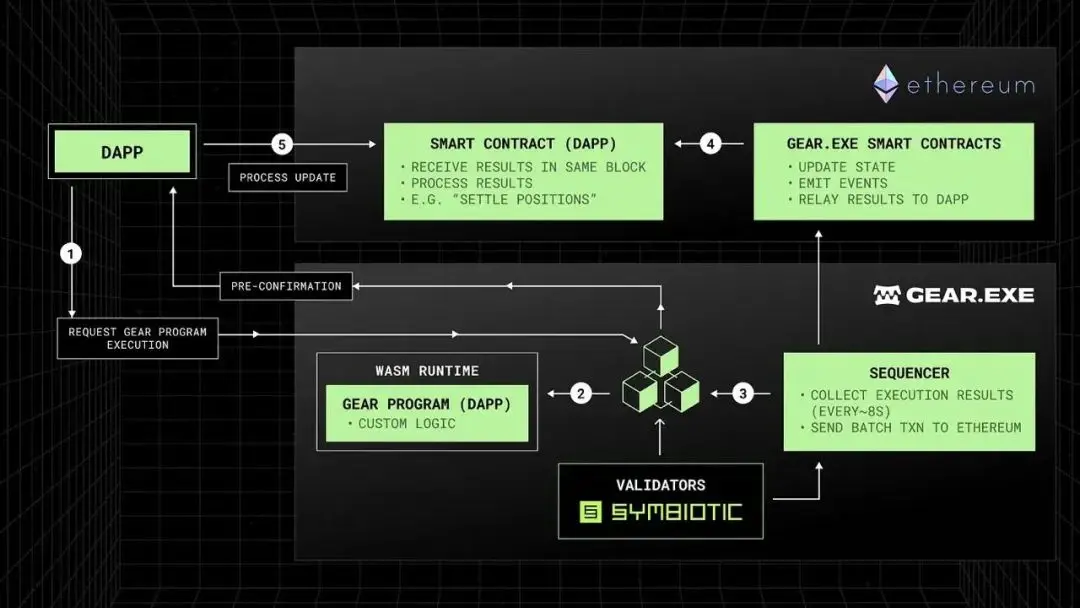Author: GearFans
Build on Vara

We are proud to introduce Gear.exe—an open-source decentralized computing network built on the Gear Protocol. It supports infinitely scalable parallel execution, with computing power increased by up to 1000 times, providing a real-time experience for high-performance dApps on Ethereum.
Seamless scaling of the Ethereum network without asset cross-chain
As an extension of the Ethereum network, Gear.exe does not face additional asset sharding or cross-chain bridging issues. Users can continue to use familiar tools (such as Metamask and Etherscan), enjoying a smooth user experience comparable to Web2 and nearly zero transaction costs.
The Ethereum ecosystem is the first application scenario for Gear.exe. As a Rust-based general solution, Gear.exe has good scalability and can be applied not only to other EVM-compatible chains in the future but also to non-EVM blockchains.
Current status and challenges of Ethereum scaling solutions
The current design of Ethereum and EVM faces some challenges that have not yet been fully resolved:
Lack of computing power: Ethereum cannot achieve parallel execution, leading to low utilization of computing resources.
High latency and low final confirmation speed: The confirmation delay for each transaction is 5-20 seconds, with an average final confirmation time of 12.8 minutes, and existing scaling solutions may further slow down the speed.
These issues make it costly and inefficient for developers to perform complex interactions on the Ethereum mainnet, thereby stifling innovation and composability. As a result, Ethereum is facing competitive pressure from other public chains (such as Solana). Solana's monthly active users and transaction volume have surpassed the total of Ethereum and other EVM chains.
Rollups are the current mainstream scaling solution, but they have obvious limitations and new problems. While they help improve the underlying TPS (transactions per second), Rollups are still single-threaded EVM machines that only provide lower transaction fees under low load. Additionally, they operate in isolated environments, leading to fragmentation of users and liquidity. These limitations have triggered the "parasitic L2" phenomenon, and the overall improvement in user experience is quite limited. Moreover, most Rollups cannot directly inherit the security of Ethereum (only 2 out of 45 Rollups have reached the first stage of security standards).
This leaves room for alternative scaling solutions: regardless of which L1 or L2 ecosystem users and developers come from, significantly enhancing computing power without bridging and significantly optimizing user experience is the goal pursued by current or next-generation applications.
Gear.exe: A new solution for dApp expansion and innovation
In 2023, Gear Protocol launched Vara Network, an L1 blockchain that uses a high-performance execution engine. Now, we officially introduce Gear.exe, a decentralized computing network that helps developers integrate the parallel processing capabilities of the Gear Protocol into Ethereum dApps, achieving unprecedented performance improvements and functional innovations.
Core advantages of Gear.exe:
Computing power increased by up to 1000 times
Transaction fees reduced by 90%-99% (can also adopt a reverse Gas model to provide users with fee-free transactions)
Sub-second latency (through pre-confirmation) and fast confirmation on the Ethereum mainnet (limited only by block time)
Web2-level user experience
Optimized Rust development environment
Gear.exe is designed for developers who need external complex computing tasks, providing a new dApp scaling solution without sacrificing decentralization, security, or scalability, addressing the limitations of existing L2 Rollups.
By utilizing the Actor model and asynchronous programming, developers can create custom Gear programs that easily achieve parallel computing and asynchronous message processing. These programs are written in Rust—a programming language known for its high performance and security.
This design significantly enhances scalability and fault tolerance (the ability of the blockchain to operate normally even when some nodes fail or act maliciously), making it an ideal environment for building feature-rich, compute-intensive dApps, such as:
DeFi protocols
Gaming platforms
Artificial intelligence and machine learning models
Verifiable and trustworthy zero-knowledge proof (ZK) computations
Additionally, infrastructure and middleware protocols can also leverage Gear.exe, such as oracles that need to submit large datasets and quickly respond to off-chain events. Performing external computations through Gear.exe and synchronizing the results back to Ethereum can significantly reduce transaction costs while ensuring the security and integrity of data transmission.
How Gear.exe Works
Unlike L2 solutions, Gear.exe is not a blockchain—it does not generate blocks or maintain a shared state. Instead, it is a highly flexible decentralized computing network that offers various integration methods, mainly including the following two:
1. Native Integration
- dApps can directly call programs running on Gear.exe without first emitting events from Ethereum, achieving real-time interaction.
2. Event-based Integration
Smart contracts on Ethereum can emit events to request the execution of Gear programs.
The validating nodes of Gear.exe will detect the events and immediately run the corresponding programs.
Achieving true decentralized integration.
Regardless of the chosen integration method, the process is as follows:
Validator nodes execute the Gear programs defined by the dApp developers and sign the results.
Symbiotic shared security protocol provides economic security guarantees and ensures that validator nodes do not act maliciously through a penalty mechanism.
The sequencer collects all Gear program execution results and their new state root hashes, packages them into batch transactions, and sends them to the Gear contract on Ethereum.
The execution results will be returned to the corresponding dApp contract, which can dynamically respond based on the results of off-chain computations.
Vara tokens will be used alongside ETH for network staking, governance, and fee payments, providing security for the network.

This architecture provides developers with ample flexibility to implement complex functions while ensuring users can seamlessly use dApps, reducing friction in operations. The design of Gear.exe breaks through the limitations of traditional scaling solutions, enabling developers to more easily build powerful and efficient next-generation decentralized applications.
Conclusion: The transformation brought by Gear.exe
Gear.exe brings disruptive changes to Ethereum users and developers, opening up new possibilities that were previously unattainable. With near-zero Gas fees (even supporting fee-free transactions), parallel computing, low latency, fast confirmation, seamless integration, and no need for bridging, Gear.exe has become the ideal platform for developers pursuing an exceptional user experience, enhancing application adoption rates and performance, and is the best choice for building the next generation of decentralized solutions.
Currently, Gear.exe has been launched on the Holesky Ethereum testnet and is continuously being optimized, with code being submitted to the public code repository daily. Gear.exe plans to officially launch on the Ethereum mainnet in the near future.
免责声明:本文章仅代表作者个人观点,不代表本平台的立场和观点。本文章仅供信息分享,不构成对任何人的任何投资建议。用户与作者之间的任何争议,与本平台无关。如网页中刊载的文章或图片涉及侵权,请提供相关的权利证明和身份证明发送邮件到support@aicoin.com,本平台相关工作人员将会进行核查。




